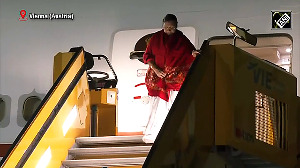The middle class in India has the sense that it is coming into its own; that it has acquired the numerical strength (300 million and more, if you use a fairly loose definition) to make the Indian market matter even in a global context; and to demand that their issues be addressed when elections come round.
The cacophony on television, the visible shift in focus of the general newspapers (out with coverage of city slums, in with coverage of shopping malls), the rush to start new airlines and the obvious international interest in India, all say the same thing: the middle class in India has arrived.
Didn't Indian airline companies account for close to half of all the new Airbuses ordered at the Paris air show? QED.
Is it that open and shut, or is there room for doubt? Looking at how the political system does not respond to the need for basics (like clean water and reliable power) would straightaway belie the claim that the middle class has political clout, but what of the other posers?
As always, the NCAER (or National Council of Applied Economic Research) survey of households gives us interesting answers to these vital questions.
It is a shock to discover, for instance, that despite the evident emergence of a strong middle class, barely 10 per cent of all households have life insurance cover--traditionally the first form of savings for anyone with a reliable income flow and with dependants.
And medical insurance is available for barely 1 per cent of all households!
There is worse to come. Only 2 per cent of households have credit cards (so much, then, for the vaunted advent of plastic money). Even that basic item in a middle-class household, the refrigerator, exists in only a sixth of all households in the country (probably because only a third of rural households have a domestic electric connection!).
It might be as much of a surprise to know that half of all the TV sets sold in the country are either black and white, or small (i.e. 14-inch) colour sets.
The only items of truly mass consumption remain daily consumables like cooking oil and washing and toilet soaps (which should really be classified as necessities, not options), followed some way behind by shampoos.
Among consumer durables, the ones used most often are not the stuff of contemporary middle class legend, and are either table/ceiling fans or bicycles. The first category sells about 37 million each year, the second about 25 million.
In other words, what appears a normal lifestyle to the average city youngster working in an office is completely abnormal for the majority, in both towns and cities (just as it is completely abnormal to speak and write in English -- only about 6 per cent do that).
From this, it is a short leap to yielding to the obvious appeal of CK Prahalad's thesis, that your "fortune lies at the bottom of the pyramid"; in other words, if you want to make big bucks in the Indian market, you had better serve customers with really low-cost goods and services.
Certainly, the evidence of the mobile phone industry and of cable TV bears this out; both expect their customers to pay no more than a few hundred rupees every month, for a fairy nominal cost, and they add enormously to the quality of life and to productivity.
The NCAER projections till the end of the decade do show, however, that for almost any category of product the market will double in terms of annual sales.
Some will do even better, while others will grow slowly. So most businesses can be said to have a good future if they can find their customers. That means more airports, more flights, many more cars. . . the full works.
That's because the size of the middle class itself will grow sharply in the coming years. But while there will be plenty of reason to celebrate the Indian party, the NCAER projections show that even in 2009-10 the middle class will be an island in a larger ocean of non-consuming classes.
Time we got a little impatient with the pace of change and economic reform?







 © 2025
© 2025